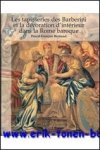Bertrand, P , F - tapisseries des Barberini et la decoration d'
| Schrijver: | Bertrand, P , F |
|---|---|
| Titel: | tapisseries des Barberini et la decoration d'interieur dans la Rome baroque |
| Uitgever: | , Brepols - Harvey Miller, 2005 |
| Bijzonderheden: | Hardcover , 343 p., 153 b/w ill. 16 colour ill., 245 x 297 mm, Languages: French, fine copy !!. ISBN 9782503516684. |
| Prijs: | € 112,00 |
| Verzendkosten: | € 6,99 (binnen België) |
| Meer info: |
The subject of this book is tapestry, with a particular focus on the function and use of hangings, and on the eventuality or necessity of owning them in the modern world. It is thus viewed from an angle warranted by an inquiry into the determination of the object. The relationship of that object to the place for which it was intended or in which it is used is a crucial point, for, by its very nature, tapestry can be easily moved and can take on a new meaning in a different setting. This apparent truism is rendered complex by the specific characteristics of tapestry, which places any analysis in the dual perspective of furnishings on the one hand and of large-scale architectural decor on the other and touches at the same time on the sociology of art and its reception. The point of departure for this study is the celebrated Barberini family, which assumed a prominent position within Roman nobility by virtue of the authority of Urban VIII, who was elected Pope in 1623. Patrons of the Arts and Letters, the Pope and his nephews, Cardinals Francesco and Antonio Barberini, as well as Prince Taddeo, brought together more than nine hundred tapestries to adorn their sumptuous palaces and to decorate churches for ceremonial occasions. The sources drawn on consist of a vast ensemble of archival documents (inventories, records of payments and correspondence) from the Vatican Library. The first two parts deal with the problem of individual taste for a given type of object, tapestry in the present case. They pay particular attention to the manifestations of the Barberini?s interest in it, to their admiration for such and such a hanging, and to their private commissions. They inquire into the significance of the foundation of the family tapestry works by Cardinal Francesco Barberini. The third part is based on a discussion of the daily use of the tapestries in palaces, but also of occasional use for events on festive or ceremonial occasions outside, in the streets of the city, or in churches. This part in fact attempts to answer the question as to the way in which, in a hierarchical and codified society, an interest in a given art form can be expressed in interior decoration in a way that allows awareness of its specific characteristics. The fourth part is concerned with the notion of patrician collection and the dispersion of the latter. Nearly two-thirds of the extant tapestries have been localized in the United States, in the museums of Boston, New York, Philadelphia, Cleveland, Flint, Minneapolis, San Francisco, etc., Charles M. Ffoulke, a Washington collector, having bought an important lot from the Barberini family in 1889. The fifth and last part analyses the process of tapestry-making, with special emphasis on the drawing up of models and cartoon. Urban VIII and Francesco Barberini were particularly attentive to the quality of the design and of the weaving itself, carried out in the most famous workshops of Brussels, Paris and Rome. It has thus been possible to reconstitute the elements of an aspect of the Barberini taste on the basis of a study of their tapestries. Pascal-Francois Bertrand is Professor of Art History at the Universite de Pau et des Pays de l?Adour. Le propos de ce livre est de mener une reflexion sur la tapisserie, en portant principalement l?attention sur la fonction et l?usage des tentures, sur la contingence ou la necessite d?en posseder a l?epoque moderne, une question motivee par une interrogation sur la determination de l?objet. Quel est le rapport instaure entre l?objet et le lieu pour lequel il a ete concu ou dans lequel il est utilise, car le lieu peut changer en raison de la nature de la tapisserie qui est aisement transportable, de maniere a en renouveler le sens? Cette question, simple en apparence, est rendue complexe par la specificite meme de la tapisserie qui place son analyse a l?intersection de deux champs d?etude, celui de l?ameublement et celui du grand decor, touchant ainsi a la fois a la sociologie de l?art et a sa reception. Cette etude a ete menee a partir de l?exemple des Barberini, une illustre famille qui s?est imposee au sein de la noblesse romaine par l?autorite d?Urbain VIII, elu pape en 1623. Protecteurs des lettres et des arts, le pape et ses neveux, les cardinaux Francesco et Antonio Barberini et le prince Taddeo, ont rassemble plus de neuf cents tapisseries pour meubler leurs somptueux palais et decorer les eglises lors des fetes et grandes ceremonies. Elle repose sur un vaste ensemble de sources documentaires (inventaires, livres de comptes, correspondance) de la Bibliotheque vaticane. Les deux premieres parties touchent a la notion de gout d?une personne pour un type d?objet en particulier, la tapisserie dans le cas present. Elles s?attachent aux manifestations de l?interet des Barberini pour ce type d?objet, a leur admiration pour telle ou telle tenture, a leurs commandes particulieres. Elles s?interrogent sur le sens de la fondation par le cardinal Francesco Barberini d?une manufacture familiale de tapisserie. La troisieme partie repose sur l?analyse de l?usage des tapisseries au quotidien, dans les palais, et aussi de maniere ponctuelle lors de manifestations, a l?occasion de fetes et de ceremonies, a l?exterieur, dans les rues de la ville, et a l?interieur des eglises. Elle est motivee par la question de savoir comment dans une societe hierarchisee, codifiee, un interet porte a une expression artistique peut etre ressenti dans la decoration d?interieur et de quelle maniere afin d?en percevoir sa specificite. La quatrieme partie a trait a la notion de collection gentilice et a sa dispersion. Pres des deux-tiers des tapisseries subsistantes ont ete localisees aux Etats-Unis d?Amerique, dans les musees de Boston, New York, Philadelphie, Cleveland, Flint, Minneapolis, San Francisco, etc., car, en 1889, Charles M. Ffoulke, collectionneur de Washington, avait achete un important lot de tapisseries aux Barberini. La cinquieme et derniere partie analyse le processus meme de fabrication des tapisseries, en s?attachant plus particulierement aux phases de l?elaboration des modeles et des cartons, Urbain VIII et Francesco Barberini etaient tres vigilants a la qualite du dessin, et au tissage proprement dit dans les plus fameux ateliers de Bruxelles, de Paris et de Rome. C?est une partie du gout des Barberini qui a ainsi pu etre reconstituee a partir de l?etude de leurs tapisseries.
|

De verkoper zal binnen 3 werkdagen contact met u opnemen om de koop verder af te handelen.
Het huisnummer is ook opgegeven in het straat veld. Gelieve controleren of de velden straat en huisnummer correct zijn opgegeven.
Straat:
Nummer:
- Alle boeken zijn compleet en verkeren in normale antiquarische staat, tenzij anders beschreven. Kleine onvolkomenheden, zoals een ingeplakte ex-libris of een naam op het schutblad, zijn niet altijd vermeld
- U handelt deze order direct af met Erik Tonen Books
Dit boekwinkeltje is een zakelijke verkoper. Hierdoor heeft u o.a. herroepingsrecht waarmee u het boek binnen 14 dagen na ontvangst retour kunt sturen. Verder lezen. - Na uw bestelling ontvangen u en Erik Tonen Books een bevestiging per e-mail. In de e-mail staan de naam, adres, woonplaats en telefoonnummer van Erik Tonen Books vermeld
- De Koper betaalt de verzendkosten, tenzij anders overeen gekomen
- Erik Tonen Books kan betaling vooraf vragen
- Boekwinkeltjes.nl probeert Kopers en Verkopers tot elkaar te brengen. Boekwinkeltjes.nl is echter nimmer partij bij een overeenkomst die gesloten wordt tussen Koper en Verkoper door gebruikmaking van de site. Als u een geschil hebt met één of meer gebruikers, dient u dit zelf op te lossen. U vrijwaart Boekwinkeltjes.nl van enigerlei vorderingen, aanspraken op schadevergoeding en dergelijke, verband houdende met dergelijke geschillen.
Onthoud mijn gegevens
Registreer u vrijblijvend als koper!
Besteld, hoe nu verder?
De verkoper zal binnen 3 werkdagen contact met u opnemen om de koop verder af te handelen. Afhankelijk van uw locatie heeft u in de meeste gevallen binnen 2 dagen uw bestelling in huis.


